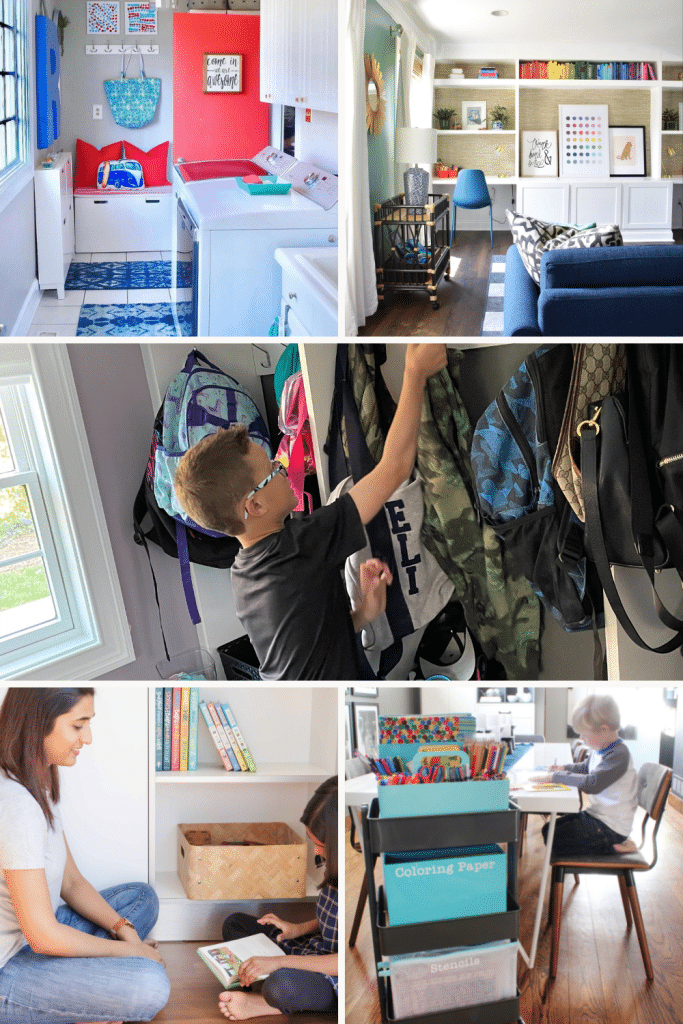Montessori-inspired Back-to-School Organisation
Going back to school is a phase that can be both exciting and challenging at the same time for the whole family. With a little planning, the transition from vacation mode to school mode can be made smooth.
Children between the ages of 0-6 are highly sensitive to external order, routines & structure. They WANT an environment where they can consistently predict what would happen next and where things must go which makes them feel safe and secure in their environment.
External order internalises during the early years before it develops into ‘intellectual organisation’ when the child is older (they still need routines & order). Disorder leads to a rise in cortisol (the stress hormone) levels & is detrimental to the child’s physical, psychological & intellectual development.
Parents often believe that their children are too young to organise, and it would be quicker if they helped their children with organising tasks or putting away their things. When this happens, children don’t feel their parents’ trust in their ability to take care of their belongings.
Hence as parents, it is our duty to:
understand this development need & natural tendency of order in our children
provide an orderly physical environment (a place for everything & everything in its place) where children know how to find & put back their things independently
set up consistent daily rhythms and routines (an intangible aspect of order) so our children know what to expect when
be patient, provide opportunities to practice & have realistic expectations (& not perfection!)
Here are 5 tips to get organised for a fuss-free school year!
1. Preparing Our Children
Before school starts (perhaps a month in advance), start having conversations with your children about their new teacher, classmates, and classes. Without a fear of the unknown, children are less likely to be anxious. Get them to talk to you about what they’re excited about and address any concerns with empathy. If it’s possible, arrange for a tour of the school especially if it’s a new environment for them. If this cannot be arranged, you could show them a virtual tour of the school or pictures.
Orientation to a new place, routines, and other tangible aspects of school helps children feel trust, safety, and security and they are more likely to adjust without much challenge.
2. Decluttering Their Space
In my family, we declutter the children’s spaces along with them every 6 months (typically during their summer and winter breaks). When clearing their shelves to make room for things for the new school year, involve your children in the decision-making process. Ask them, “Do you need this in school next year? Does this artwork make you happy? Where shall we put this?”. Provide a child-sized spray bottle & cloth to wipe down the shelves!
During the decluttering process, start with their clothes first including uniforms, bags, and shoes (donate items that no longer fit and store those they’re not ready for on higher shelves of their closets in designated containers), move on to their books (recycle used notebooks and donate textbooks to those in need), their toys (including art material) and finally their completed crafts and artwork. Guide them in deciding what fits them well, will be needed for school, and gets them excited to begin the academic year.
Look through their school supplies list together and see what items are truly needed before purchasing them. This teaches them to be mindful & intentional with their shopping. Encourage them to wash their shoes & schoolbag before school starts. Provide a child-sized bucket & brush and you’ll be surprised to see how much fun they have while they clean their own things. They’re learning how to be responsible for caring their belongings too.
Involve your children from as young an age as possible in the decision-making process of creating their environment. Give them choices to choose from (where the end results are what the adult is happy to accept) using these prompts: “Where shall we put this? What would you like to keep based on the space we have? What do you think?” “Do we really need this? How often do we think we will use it? Can we rent/borrow it? Will we use this for a short period of time or longer?” Children feel respected, capable, self-confident & self-reliant when systems are created with them.
3. Preparing Respectful Spaces
Think about their different transition periods during the day and create spaces that empower your children’s independence.
Entryway: The entryway can quickly get chaotic if spaces are not designated for their school belongings. Providing a consistent location for storing each child’s school bags, shoes and a laundry basket (one for the home) for dirty laundry makes it intuitive for children to put away their things without nagging them. You could consider baskets or wall hooks for each of the sub-categories.
Workspace: Your workspace could have a pending papers tray where they can place their paperwork that needs your attention. Similarly, their worktable could have a “completed work” paper tray so they can pack the papers that you’ve looked at the night before. An art caddy or art trolley that is mobile can be moved to different locations of the home and store items like stationery and art materials neat & organised for easy access. Having a clock and a calendar/notebook to write down their daily tasks also helps them manage their time while getting work done.
Snacks Station: Designate a lower shelf of a kitchen closet to store healthy snacks like nuts, granola, or cookies (we prefer digestives or those with less sugar) in containers that are easy to manipulate by your children. Keep servings small so that even if they empty out all the contents into their snack boxes, you’re ok with that. You could also have a small bowl of fruit like grapes or bananas that require lesser preparation. Designate a container for 1-2 snack boxes and their water bottles. Limit their choices so it doesn’t overwhelm them. If you have time the night before, encourage them to pack their snacks then.
Label their belongings and containers wherever necessary so that they know where things go without any ambiguity. You might find my earlier blog post here useful on the benefits of using the KonMari® and Montessori principles in creating organised spaces around the home with your children.
4. Creating a Command Station
Children thrive on routines. One way to do this and help children feel capable while avoiding power struggles is to involve them in creating their own 'Responsibility Chart' (either by using pictures or writing them down). This chart can include morning routines, after-school tasks as well as bedtime routines. Instead of us nagging at our children to get jobs done, the chart guides them on what needs to be done next. All you need to ask is "What's next on your chart?" and wait for your child to answer.
Now that my children are older, they have moved away from the visual routine cards they once used (see picture above; this blog post explains how we used to use these) & prefer an editable chart where they have more flexibility in adding tasks that they feel they need reminders on.
We have created a visual command station in our home using magnetic charts on the refrigerator. These include a responsibility chart (aka routine chart) that is editable and each of my children use different coloured markers to track their progress, a weekly schedule chart so the everyone is aware of the family’s schedule and activities, and an agenda chart that we use for our weekly family’s meetings that documents challenges or wins we discuss together.
The more children do for themselves, the more capable and encouraged they feel. There is a higher chance of them completing tasks that they were involved in creating and it is our job as parents to give them plenty of opportunities to show us (& themselves) that they are capable.
5. Shifting Rhythms
As the first day of school draws closer, shift your children’s daily rhythms to match that of school. We do this in our home around 2 weeks before school starts. Gradually bring bedtime earlier, provide an alarm clock and teach them how to use it so they learn how to wake up on time on their own, match mealtimes to those during school weeks and prepare them for after school activities so they know what to expect.
Finally, you can write them a note of affirmation and include it in their snack bag every day. These will help you connect with your child in a positive manner even when you’re not with them. Some phrases I like to use are:
You can do anything you set your mind to
You light up every one of my days!
Have I told you yet today how much I love you?







